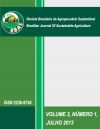PRODUÇÃO E COMPOSIÇÃO QUÍMICA DE BRACHIARIA DECUMBENS CV. BASILISK EM SISTEMA SILVIPASTORIL SOB DIFERENTES ESPAÇAMENTOS COM EUCALYPTUS UROPHYLLA S.T. BLAKE
DOI:
https://doi.org/10.21206/rbas.v3i1.193Resumo
O objetivo deste estudo foi avaliar o efeito do espaçamento de plantio do eucalipto em sistema silvipastoril sobre a produção e composição química da Brachiaria decumbens. Foram utilizados quatro tratamentos, referentes aos três espaçamentos de plantio do eucalipto (3x2, 6x4 e 10x4 m), mais o tratamento controle (ausência de árvores). O delineamento experimental utilizado foi em blocos completos casualizados, com quatro tratamentos, quatro blocos e duas repetições por bloco, e análise dos dados foi realizada como medidas repetidas no tempo. Constataram-se efeitos significativos de tratamento para a massa de forragem (MF) e taxa de acúmulo de massa seca (TAMS). Para a relação folha/colmo (F/C), porcentagem de proteína bruta (PB), porcentagem de fibra em detergente neutro (FDN) e porcentagem de matéria mineral (MM) não foram observados efeitos de espaçamento de plantio do eucalipto. Em conclusão, verificou-se que os espaçamentos de plantio afeta tanto a produção quanto a composição química da braquiária avaliadas até os 24 meses de crescimento do Eucalyptus urophylla cultivado em sistema silvipastoril.Downloads
Downloads
Publicado
2013-07-01
Como Citar
Raphael Pavesi Araujo, João Carlos de Carvalho Almeida, Saulo Alberto do Carmo Araújo, Everton Teixeira Ribeiro, Fábio Teixeira de Pádua, Carlos Augusto Brandão de Carvalho, Talita Pinheiro Bonaparte, Bruno Borges Deminicis, & Fábio Nunes Lista. (2013). PRODUÇÃO E COMPOSIÇÃO QUÍMICA DE BRACHIARIA DECUMBENS CV. BASILISK EM SISTEMA SILVIPASTORIL SOB DIFERENTES ESPAÇAMENTOS COM EUCALYPTUS UROPHYLLA S.T. BLAKE. Revista Brasileira De Agropecuária Sustentável, 3(1). https://doi.org/10.21206/rbas.v3i1.193
Edição
Seção
Artigos
Licença
1. Proposta de Política para Periódicos de Acesso Livre
Autores que publicam nesta revista concordam com os seguintes termos:
Autores mantém os direitos autorais e concedem à revista o direito de primeira publicação, com o trabalho simultaneamente licenciado sob a Licença Creative Commons Attribution que permite o compartilhamento do trabalho com reconhecimento da autoria e publicação inicial nesta revista.











